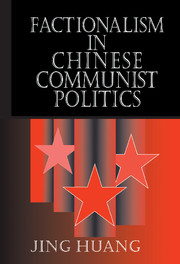Book contents
- Frontmatter
- Contents
- List of Figures and Tables
- Preface
- List of Abbreviations
- Introduction
- 1 Factionalism, the Puzzle of Chinese Communist Politics
- 2 Factionalism and the Political System in China
- 3 The Establishment of the Yan'an Round Table
- 4 The Transition of the Yan'an Round Table
- 5 Crises in Leadership Relations with the Two-Front Arrangement
- 6 The Collapse of the Yan'an Round Table and the Unleashing of Factionalism
- 7 Deng Xiaoping's Dominance: Factionalism Prevails over the Party Spirit
- 8 Conclusion
- Selected Bibliography
- Index
5 - Crises in Leadership Relations with the Two-Front Arrangement
Published online by Cambridge University Press: 11 September 2009
- Frontmatter
- Contents
- List of Figures and Tables
- Preface
- List of Abbreviations
- Introduction
- 1 Factionalism, the Puzzle of Chinese Communist Politics
- 2 Factionalism and the Political System in China
- 3 The Establishment of the Yan'an Round Table
- 4 The Transition of the Yan'an Round Table
- 5 Crises in Leadership Relations with the Two-Front Arrangement
- 6 The Collapse of the Yan'an Round Table and the Unleashing of Factionalism
- 7 Deng Xiaoping's Dominance: Factionalism Prevails over the Party Spirit
- 8 Conclusion
- Selected Bibliography
- Index
Summary
Why did Mao Zedong launch the Cultural Revolution? Few would dispute that the answer lies in CCP politics between 1956 and 1966, but explanations vary greatly. The CCP official account explains the CR as a result of the conflict between Mao's “Left-deviationist error” and his colleagues' persistence in the “correct policies”. Numerous scholars also attribute the CR to policy differences among the CCP leaders. A few emphasize Mao's deep-seated antibureaucratism, or focus on “the politics of succession” in the leadership, or see the CR “essentially as an aberration”, resulting from changes in the political environment that put different constraints on Mao and his colleagues in decision making. The power-struggle analysts see the CR originating in the elite struggles for power, although these struggles were often triggered by policy disputes.
This chapter examines CCP politics in 1956–66 from the perspective of the structure of leadership relations. It shows that the CCP leaders' policy choices were essentially structure-induced after the two-front arrangement was set up in policy making (see Chapter 4). That is, given his policy preferences and guanxi with the other leaders, a leader's rationale in decision making was eventually subject to the constraints of the two-front arrangement.
The two-front arrangement was adopted to solve Mao's dilemma in the policy process: Mao had to keep all manner of control flowing to him in order to maintain his command, yet it was too much a task for him to follow every policy issue closely.
- Type
- Chapter
- Information
- Factionalism in Chinese Communist Politics , pp. 211 - 266Publisher: Cambridge University PressPrint publication year: 2000



